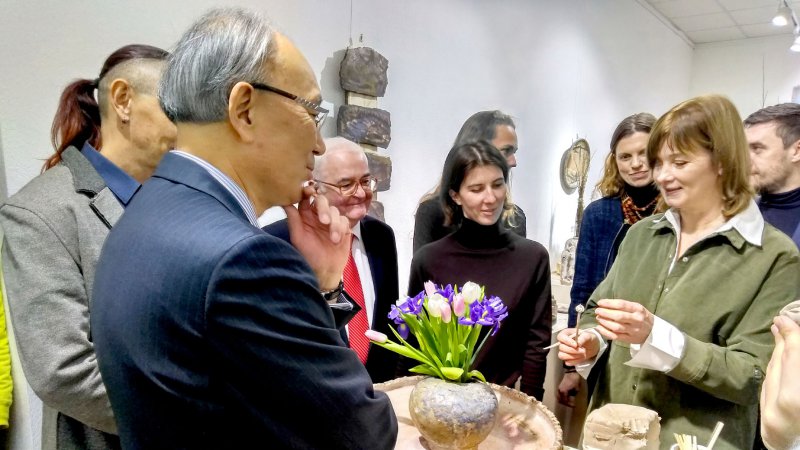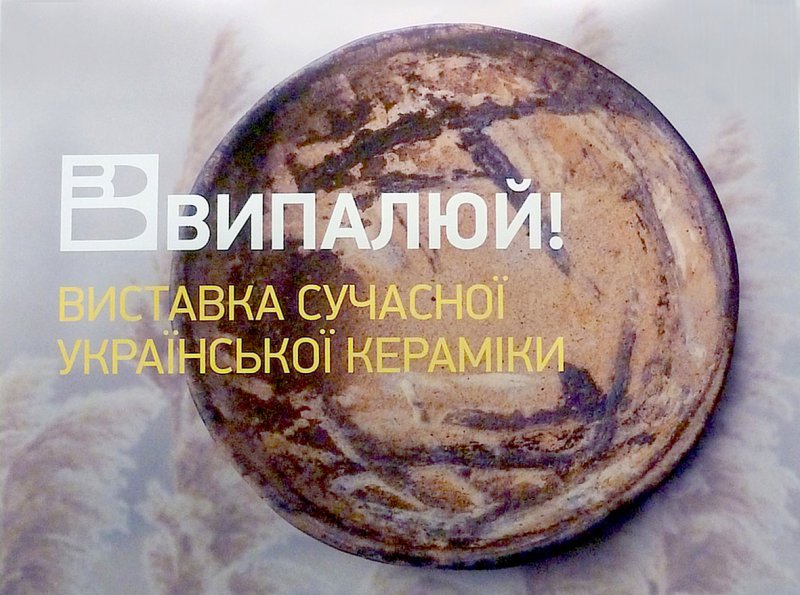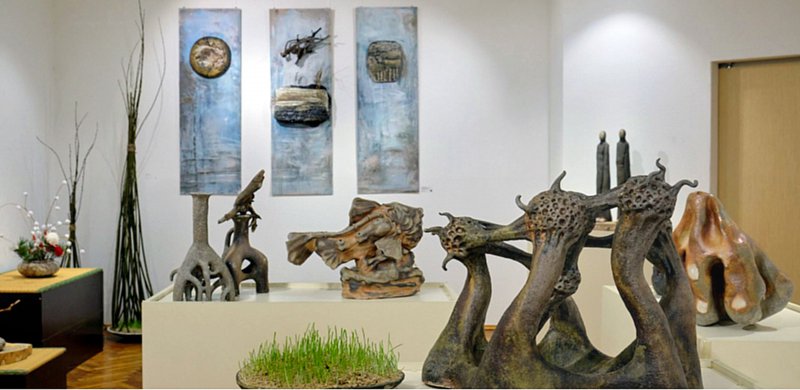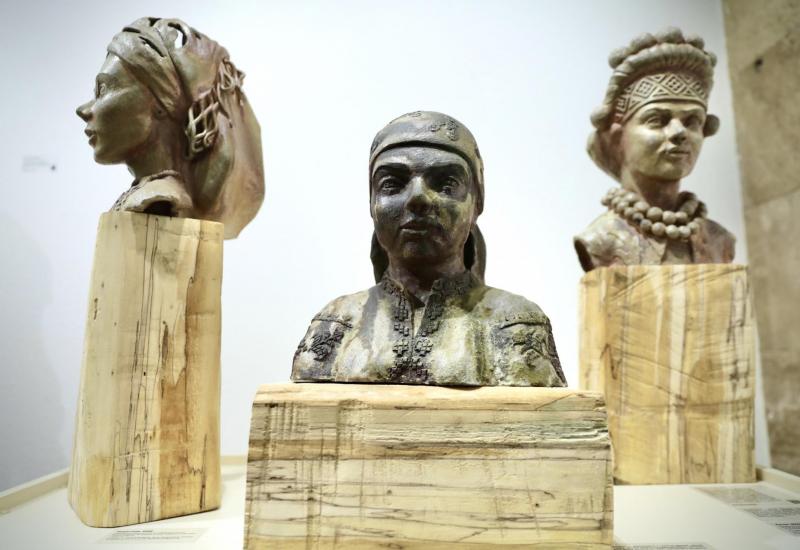Once I read that it is better to watch the sculpture in the evening or at night, preferably by candlelight, but it is also possible with a half-light of flashlights.
Because, they say, in that light it seems to come alive, and is perceived completely differently than in broad daylight. I did not have the opportunity to watch this until the end of last year. And on the rather gloomy December 15 last year, this would not have happened either, if it were not for another power outage in Kyiv.

The fact is that in the evening of that day the exhibition of Ukrainian ceramic artists’ works "Outburn!" was opened in the Ukraine-Japan Centre of the Igor Sikorsky Kyiv Polytechnic Institute, which works at the university Scientific and Technical Library. The name of the exhibition is in a way ambiguous, but first of all it reflects the technology of creation of the things shown in it, because they were all outburned according to a special ancient technology in a traditional Japanese wood-fired anagama kiln.
And when suddenly a blanket of velvet darkness covered the small exhibition hall, and the participants of the vernissage (and there were many of them!) began to turn on their smartphones and flashlights, it turned out that the conversations about the special perception of works of plastic art, particularly original ceramics, under dim, flickering lighting, - this is not an exaggeration! The things presented at the exhibition are traditional for decorative and applied art, the most ancient of which are ceramics. Dishes and flower vases, whimsical root-like compositions, anthropomorphic figures, girls' heads made in a completely realistic style, etc. really looked warm, and as if invited to know their warmth by touch (the latter is definitely not really welcomed, as in all exhibitions and museums).

Ukrainian ceramics with Japanese roots
Nevertheless, the presented works look no less attractive even in full light. A little different, but still elegantly simple. This is a feature of Japanese ceramics with its distinctive aspiration for naturalness. This is the reason why the masters of some traditional styles even leave the surfaces of their products as if unfinished - with blotchiness of clay elsewhere, with barely visible fingerprints, certain, as if accidental, but actually thought-out "defects". The vast majority of the works presented at the exhibition look like this - quite simple, but at the same time extremely exquisite, and thanks to their non-accidental "imperfections" absolutely unique, but, at the same time, as if familiar from childhood. Such is Japanese art, passed through the Ukrainian soul and worldview.
In fact, it cannot be otherwise, because 11 Ukrainian ceramic artists who are fond of Anagama wood firing participated in this project. They presented 30 works at the exhibition, on which they worked for two months, and they held their joint 96-hour Anagama wood firing in the Art Gudenky Residence, located in the suburbs of Kyiv at the end of October.
The Embassy of Japan in Ukraine granted the exhibition the status of a festive event dedicated to the 30th anniversary of the establishment of diplomatic relations between Japan and Ukraine. There's a great depth of meaning in it, because what can express the deep affinity of two countries better than a synthesis of the historical artistic styles and techniques of one of them with their reinterpretation by the masters of the other on the basis of their own artistic traditions and experience?

Not only about art
In such days they definitely did not only talk about art at the vernissage. "Over the past thirty years, Ukraine has become a truly democratic country that will soon join the European Union," Matsuda Kuninori, Ambassador Extraordinary and Plenipotentiary of Japan to Ukraine, said." - As you know, Japan is a member of the G7 Group. And in 2023, Japan will preside over this "Great Seven". In 2023, I will head the group of ambassadors of the G7 member states, created in Kyiv to support Ukraine. I want to promise three things. First, I promise to support Ukraine in its efforts to win this war as soon as possible together with the ambassadors of other G7 member countries. Secondly, I will take maximum efforts to strengthen the economy of Ukraine, to its renewal and reconstruction. I also plan to make this year full of cultural events, where it will be possible to meet friends from Japan and Ukraine as today." Finally, the head of the Embassy of Japan to Ukraine expressed hope (which, to some extent, sounded a promise) that at the next similar event at the Ukraine-Japan Centre of the Igor Sikorsky Kyiv Polytechnic Institute, he will be able to address its participants in the Ukrainian language.

Anagama is like a musical instrument
Tetiana Maksymchuk and Viacheslav Hudenok, the founders of the Art Gudenky Residence and the curators of this art project, addressed the participants of the vernissage. Active researchers of modern artistic practices in ceramics, they actively use them in their own creative activities. The ceramic traditions of Japan inspire them to creative exploration of new ideas and forms. Their speech was devoted to the special aspects of the project.
"The mission of the project was to inspire our potters to resume artistic activity in the wartime, and to feel the creative spirit we had before the war again," - Viacheslav Hudenok explained.
Tetiana Maksymchuk spoke about the peculiarities of the traditional Japanese outburning technology, which united Ukrainian art pottery masters, and about their work: "Anagama kiln is very similar to a musical instrument. But an instrument that can not only be played by one person, but by a whole team as well. Because the firing itself lasts four days of constantly adding firewood, monitoring the temperature, loading and unloading the furnace! One or two people are not even physically able to bear such a thing. And the chamber itself is too big to outburn one or two things in it... It was the first wartime firing. After all, art cannot be silent even when there are volleys of cannons and sounds of sirens. And art is not silent! So, we were able to whisper in our works all our thoughts, all our worries, all our stress over loved ones who are in different corners of our country. I really hope you will feel it looking at our works..."
We should add that the anagama kiln in the Art Gudenky Residence is the largest in Ukraine. It was built in 2020 and has already become a real epicenter of joint art projects, a place of attraction for Ukrainian pottery designers who are fascinated by wood firing. So, the firing within the project "Outburn!" became the sixth after its construction.
Therefore, the initiators of the project and its participants – the NGO "Cultural Assembly", the Art Gudenky Residence, as well as the Ukraine-Japan Centre of the Igor Sikorsky Kyiv Polytechnic Institute invite you to the exhibition "Outburn!". It works at the Ukraine-Japan Centre of the Igor Sikorsky Kyiv Polytechnic Institute (Scientific and Technical Library, 4th floor, 37, Prosp. Peremohy, Kyiv) from 11:00 a.m. to 7:00 p.m. on weekdays, and from 11:00 a.m. to 6:00 p.m. on Saturday. Sunday is a day off. Free admission. The closure of an exhibition is on January 26, 2023.

